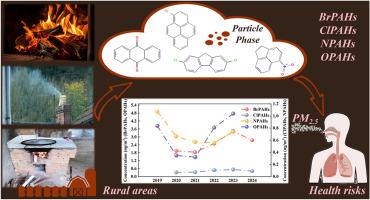2019-2024年北方农村冬季PM2.5中卤代、硝基、氧代多环芳烃浓度、化学组成、来源及健康风险变化趋势
IF 7.3
2区 环境科学与生态学
Q1 ENVIRONMENTAL SCIENCES
引用次数: 0
摘要
多环芳烃(PAH)衍生物由于其较母体多环芳烃具有更强的持久性和毒性而受到越来越多的关注。中国北方农村地区大气PM2.5浓度明显超过城市水平,主要原因是燃煤广泛存在,排放控制措施效率低下。我们在华北沿海农村地区进行了为期6年(2019-2024)的冬季PM2.5样本采集,分析了41种多环芳烃衍生物(14种BrPAHs, 7种ClPAHs, 15种NPAHs和5种opah)浓度。在2020-2021年期间,所有四种多环芳烃衍生物的浓度均显著降低,随后在2022年增加。虽然NPAHs的增加相对低于其他组,但结果仍然表明COVID-19控制措施在降低这些污染物的污染水平方面是有效的。BrPAHs、ClPAHs、NPAHs和ophs的优势种分别为7-BrDahA(21.52% ~ 26.86%)、9- clant(25.25% ~ 27.59%)、2+3N-FLT(17.62% ~ 39.14%)和9,10- atq(62.42% ~ 82.96%)。封锁措施有效减少了煤炭/生物质燃烧、交通和工业来源的贡献。疫情封城后,煤炭/生物质燃烧和交通排放迅速反弹,工业排放恢复滞后。多环芳烃衍生物终生癌变增量风险在2021年达到最低水平,限制解除后逐渐增加,均小于10-6。煤/废物燃烧是Cl/BrPAHs的主要健康风险来源,而交通排放和二次形成对npahs相关风险贡献最大。本文章由计算机程序翻译,如有差异,请以英文原文为准。

Six-year trends of concentration, chemical composition, sources and health risks of halogenated, nitro and oxygenated PAHs in winter PM2.5 at a rural area in northern China (2019–2024)
Polycyclic aromatic hydrocarbon (PAH) derivatives have attracted increasing attention due to their stronger persistence and toxicity compared to parent PAHs. Atmospheric PM2.5 concentration in rural areas of northern China significantly exceeds urban levels, primarily due to widespread coal combustion and inefficient emission control measures. We conducted a six-year winter PM2.5 sample collection (2019–2024) in rural coastal areas of North China, and analyzed 40 PAH derivatives (14 BrPAHs, 7 ClPAHs, 14 NPAHs, and 5 OPAHs) concentrations. ∑BrPAHs, ∑ClPAHs, ∑OPAHs exhibited significantly lower concentrations during 2020–2021 and followed by an increase in 2022. The results indicated that COVID-19 control measures were effective in reducing pollution levels of these pollutants. The dominant species of BrPAHs, ClPAHs, NPAHs, and OPAHs were 7-BrDahA (21.52 %–26.86 %), 9-ClANT (25.25 %–27.59 %), 2+3N-FLT (30.72 %–39.24 %) and 9,10-ATQ (62.42 %–82.96 %), respectively. The lockdown measures effectively reduced contributions from coal/biomass combustion, traffic, and industrial sources. Coal/biomass combustion and traffic emissions rebounded rapidly after epidemic lockdown, while industrial emissions exhibited delayed recovery. The incremental lifetime cancer risks of PAH derivatives reached lowest level in 2021, then gradually increased after restrictions were lifted, and all were less than 10−6. Coal/waste combustion was the dominant health risk source for Cl/BrPAHs, while traffic emissions and secondary formation contributed most to NPAHs-associated risks.
求助全文
通过发布文献求助,成功后即可免费获取论文全文。
去求助
来源期刊

Environmental Pollution
环境科学-环境科学
CiteScore
16.00
自引率
6.70%
发文量
2082
审稿时长
2.9 months
期刊介绍:
Environmental Pollution is an international peer-reviewed journal that publishes high-quality research papers and review articles covering all aspects of environmental pollution and its impacts on ecosystems and human health.
Subject areas include, but are not limited to:
• Sources and occurrences of pollutants that are clearly defined and measured in environmental compartments, food and food-related items, and human bodies;
• Interlinks between contaminant exposure and biological, ecological, and human health effects, including those of climate change;
• Contaminants of emerging concerns (including but not limited to antibiotic resistant microorganisms or genes, microplastics/nanoplastics, electronic wastes, light, and noise) and/or their biological, ecological, or human health effects;
• Laboratory and field studies on the remediation/mitigation of environmental pollution via new techniques and with clear links to biological, ecological, or human health effects;
• Modeling of pollution processes, patterns, or trends that is of clear environmental and/or human health interest;
• New techniques that measure and examine environmental occurrences, transport, behavior, and effects of pollutants within the environment or the laboratory, provided that they can be clearly used to address problems within regional or global environmental compartments.
 求助内容:
求助内容: 应助结果提醒方式:
应助结果提醒方式:


